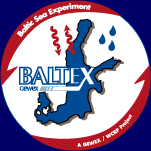BALTEX Phase II (2003 - 2012) - Introduction
Phase I of BALTEX (1993 to 2002) has brought major results in both science and infrastructure at the European level. Many BALTEX projects have been conducted - and several are presently ongoing - in different countries funded by both national and European sources. Results of the BALTEX programme are documented in more than 100 peer-reviewed journal articles including several dedicated BALTEX journal issues and overview publications. The BALTEX Community is now making plans for enlarging the scientific scope and thus strengthening the outreach of BALTEX. The numerous achievements of BALTEX call for an intensive application to other fields where knowledge on the water and energy cycle is of fundamental importance: Climate variability and climate change studies including scenarios of potential future climate, and environmental investigations related to nutrients and pollutants. Impact studies - responding to social needs and supporting decision makers in a broader context of Global Change issues related to the Baltic Sea basin - are envisaged to accompany the research efforts during BALTEX Phase II. It is important to note that the Objectives of Phase I will continue to be valid for Phase II. Activities will more closely be discussed with and - hopefully - applied by the larger user communities, even beyond the World Climate Research Programme's (WCRP) science community, including e.g. hydropower companies, water resource managers and intergovernmental bodies for the Baltic Sea and its catchments.
The launch of BALTEX Phase II in 2003 marked a major re-orientation of BALTEX research within the scope of BALTEX as a GEWEX/WCRP related programme. As such it was the first to explicitly include “air and water quality” issues and their feedbacks to the environment into the water cycle. Also, the inclusion of regional climate change, water management issues and the outreach to stakeholders, policy makers and the general public are new aspects on the BALTEX agenda. The new objectives have evolved since 2003, also due to the participation of new steering group members. Some aspects have shown to be outside of what a programme like BALTEX can achieve within its given lifetime; others have gained importance due to the availability of external funding. Thus, a review followed by some adjustments of the new objectives was deemed necessary in the light of these developments and the feasibility to reach the major goals within the current programme phase until the end of 2012. A document representing an update of the BALTEX Phase II objectives (as defined in the BALTEX Phase II Science Framework and Implementation Strategy of 2006), was published in November 2009 (see below). This updating process was initiated by the BALTEX Science Steering Group at its 22nd meeting in Norrköping in January 2008. The document takes into account the recommendations given by a task group which was BALTEX Phase II Revised Objectives 2 formed at the Norrköping meeting. Although it should be readable on its own as a comprehensive outline of the updated BALTEX Phase II objectives, it is meant as an amendment to the Science Framework and Implementation Plan of 2006, rather than a replacement. Some sections were adopted unchanged from the original document, others were amended or re-formulated.
Click here for an overview over the revised BALTEX Phase II objectives.
Click here for the document "BALTEX Phase II 2003 – 2012. Revised Objectives: A Summary Amendment to the BALTEX Phase II Science Framework and Implementation Plan" (November 2009).
Click here for the original document "BALTEX Phase II 2003 – 2012. Science Framework and Implementation Strategy" (April 2006). |

